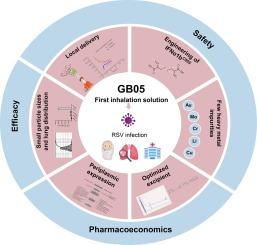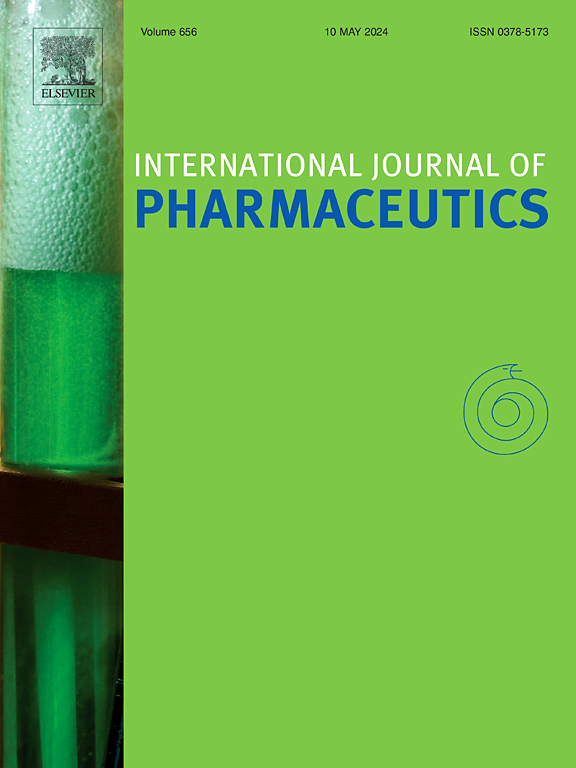GB05:治疗呼吸道合胞病毒感染安全有效的IFNα1b吸入液
IF 5.2
2区 医学
Q1 PHARMACOLOGY & PHARMACY
引用次数: 0
摘要
人类呼吸道合胞病毒(HRSV)感染与全世界婴幼儿的高发病率和死亡率有关,但目前尚无有效的治疗方法。干扰素α (IFNα)是干扰素家族中的一个主要亚型,通过激活人体免疫系统显示出抗病毒作用。气溶胶吸入是一种可以提高药效,同时降低血清IFNα浓度和全身暴露的方法,从而最大限度地减少全身毒性的风险。然而,目前,人干扰素α1b (IFNα1b)注射液在说明书外用于吸入,引起了婴儿的安全问题。此外,天然IFNα1b含有半胱氨酸残基中的游离巯基,增加了结构不稳定的风险。人血清白蛋白(HSA)是IFNα1b制剂中的一种赋形剂,可能对婴儿造成安全风险。为了解决这些问题,我们开发了gb05 -人IFNα1b吸入溶液,优化了分子设计、表达体系和配方。首先,在质周空间表达GB05蛋白,以便于纯化。用C86S突变改造GB05以防止分子间二硫键的形成。此外,GB05按照吸入溶液的规定制定,最低的HSA为0.1%,以确保安全性,同时保持生物活性和稳定性。食蟹猕猴雾化后的血浆GB05浓度显著低于肺中的浓度,表明全身不良事件的风险降低。最后,GB05在体外和体内均表现出良好的抗HRSV感染效果。总之,据我们所知,GB05是第一个报道的符合监管标准的IFN吸入溶液,由于有效的局部递送,显示出安全性和有效性。GB05将填补在治疗HRSV感染方面的空白。本文章由计算机程序翻译,如有差异,请以英文原文为准。

GB05, a safe and effective IFNα1b inhalation solution for treating respiratory syncytial virus infection
Human respiratory syncytial virus (HRSV) infection is linked to significant morbidity and mortality in infants and young children worldwide, yet no effective treatment is available. Interferon α (IFNα), a major subtype among the IFN family, has demonstrated antiviral effects by activating the human immune system. Aerosol inhalation is a way of IFN administration that can enhance efficacy while decreasing serum IFNα concentrations and systemic exposure, thereby minimizing the risk of systemic toxicity. However, at present, human interferon α1b (IFNα1b) injection solution is used off-label for inhalation, raising safety concerns for infants. Additionally, natural IFNα1b contains a free sulfhydryl group from cysteine residue, increasing the risk of structural instability. Human serum albumin (HSA), an excipient in IFNα1b formulations, may pose safety risks to infants. To address these concerns, we developed GB05-human IFNα1b inhalation solution with optimized molecular design, expression system and formulation. First, GB05 protein was expressed in the periplasmic space to achieve easier purification. GB05 was engineered with a C86S mutation to prevent the formation of intermolecular disulfide bonds. Furthermore, GB05 was formulated according to regulations for inhalation solution, with a minimal HSA of 0.1 %, to ensure safety while preserving biological activity and stability. Plasma concentrations of GB05 following nebulization in cynomolgus macaques were significantly lower than those in the lungs, suggesting a reduced risk of systemic adverse events. Finally, GB05 showed good efficacy against HRSV infection in vitro and in vivo. In summary, GB05 is the first reported IFN inhalation solution manufactured in compliance with regulatory standards, to our knowledge, exhibiting safety and efficacy due to effectively local delivery. GB05 will fill the gap in the treatment of HRSV infection.
求助全文
通过发布文献求助,成功后即可免费获取论文全文。
去求助
来源期刊
CiteScore
10.70
自引率
8.60%
发文量
951
审稿时长
72 days
期刊介绍:
The International Journal of Pharmaceutics is the third most cited journal in the "Pharmacy & Pharmacology" category out of 366 journals, being the true home for pharmaceutical scientists concerned with the physical, chemical and biological properties of devices and delivery systems for drugs, vaccines and biologicals, including their design, manufacture and evaluation. This includes evaluation of the properties of drugs, excipients such as surfactants and polymers and novel materials. The journal has special sections on pharmaceutical nanotechnology and personalized medicines, and publishes research papers, reviews, commentaries and letters to the editor as well as special issues.

 求助内容:
求助内容: 应助结果提醒方式:
应助结果提醒方式:


